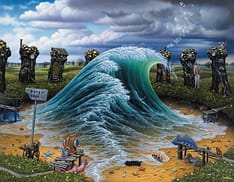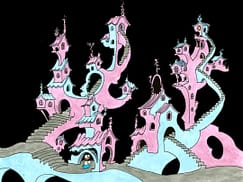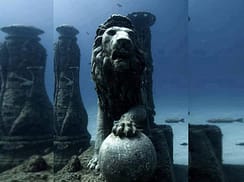
MC Escher Smaller and Smaller 1, 1956, Wood engraving and woodcut from four blocks. Reducing the size of the motif over and over gives the idea of it disappearing into infinity. Source: Fire8Storm
MC Escher (1898 – 1972)
Escher was fascinated by the perspective and depth that could be created on a flat surface and was probably one of the best graphic design artists in recent history. Spatial dimension takes on a new meaning once you delve into the works of Escher.
His most recognised technique was to start with objects he could narrow down to their two-dimensional properties, and then transform them into three-dimensional shapes of beauty. He is also known for is tessellation work, merging shapes together and often taking inspiration from nature using the forms of fish and birds.
Hand with Reflecting Globe
One of his most famous works is “Hand with Reflecting Globe”. This has been reproduced countless times over with different reflections in the globe depending on the artists intention.

MC Escher Hand with Reflecting Globe, 1935, Lithograph Source: Fire8Storm
None however, have been able to portray the same detail and exactness that the original displays.
This work highlights Escher’s obsession with differing planes and establishing depth on a flat surface.
The carefully thought out reflections in this work illustrate his understanding of perspective and space.
His work often had a deeper meaning, reflecting his feelings and observations in the world around him. About this work he said:
“His head, or to be more precise the point between his eyes, comes into the absolute centre.Whichever way he turns he remains at the centre. The ego is the unshakeable core of this world”.
Relativity
“Relativity” takes a different approach. Rather than one central point of direction for stairwells, the whole space is changing, producing three-dimensional spaces in all different directions.

MC Escher Relativity, 1953, Lithograph Source: Fire8Storm
Each area is almost isolated, with people moving around quite comfortably. In some areas the figures are walking up stairs, in others they are walking downstairs.
Looking at this piece for longer periods of time does not solve this imbalance.
The air of the surreal remains which is testament to the quality and accuracy of this work.
Escher as an Artist
Escher showed artistic flare from a young age and attended the School of Architecture and Ornamental Design in Haarlem from 1919 to 1922. He very quickly discovered his passion lay within graphic design.
Escher initially took his early influences from nature, developing his technique and practising his style to where post 1935 his imagination took over as the starting point for the majority of his works. This was brought on by a move with his family from Italy to Switzerland and to eventually settling in Holland in 1941. The dramatic change in architectural design surrounding him forced him to look for another source of inspiration which he found within himself.

“I believe that producing pictures, as I do, is almost solely a question of wanting so very much to do it well”
— MC Escher
Math and Art
Many of Escher’s artworks were mathematical in the sense of their proportions and perspectives although he had no formal mathematics training. He spent a period travelling to the Mediterranean with a shipping company which sparked his interest in symmetry and he began work with geometric grids after this time.
Escher often used tessellations in his work, titling the visual planes using geometric shapes blending into each other. His highly designed and almost scientific attention to detail and the symmetries and planes he created has drawn interest to his artwork from scientists and artists alike.
Lithography
Many of Escher’s artworks were produced using lithography. This is a printing method using a stone or metal plate with a smooth surface which is inked and then pressed onto paper. Black grease pencil is generally used to draw an image of the final print onto the smooth stone. Printing can then be carried out using water and ink layers before printing the image onto paper.
Lithography is a long and painstaking process and Escher hired a professionally trained lithographer to print his stones because of this. The process allows much more shading than other printing methods with different levels of grey through to black which was vital for his work to create the depth and perspective he needed.

MC Escher Encounter, 1944, Lithograph Source: Fire8Storm

MC Escher Drawing Hands, 1948, Lithograph Source: Fire8Storm
2D to 3D
“Encounter” shows shadows on a wall creeping into existence, moving and dancing with each other around a circle in the floor.
Escher had meaning to these forms, expressing symbols of optimism (white) and pessimism (black).
Escher felt we develop to see objects in either two dimensional or three dimensional form and he wanted to combine these perceptions in one flowing circular piece.
Another of his most famous works is “Drawing Hands”.
This again very much draws on the concept of the two dimensional merging into real life three dimensional form all on one flat surface.
The particular beauty in this piece is the level of detail and realism in the hands themselves.
“So let us then try to climb the mountain, not by stepping on what is below us, but to pull us up at what is above us, for my part at the stars’ amen”
— MC Escher
Reptiles
“Reptiles” is probably one of Escher’s most famous and most admired prints and it is easy to see why. It is certainly my favourite piece of work from his collection.
This artwork is a source of entertainment as well as a masterpiece in bringing the two dimensional gradually into three dimensions and back again.

What begins as a simple flat abstract piece of reptile shapes is disrupted as one reptile ‘escapes’ in the bottom left hand corner. This escape brings the reptile to life as he crawls his way around the obstacles in-front of him, clearly quite enjoying himself, before he returns quietly back into two dimensional abstract form.
Escher said of this work “with one plastic looking leg over the edge of the book, he wrestles himself free and climbs up the back of the book on zoology and works his way laboriously up the slippery slope of a set square to the highest point of his existence. Then, after a quick snort, tired but fulfilled, he goes downhill via an ashtray”.
This has to be the best description of a piece of artwork I have ever read. Escher’s artistic talent is obvious, but without his imagination and ability to bring shape to life, his work may not have achieved the same tremendous impact that it has.

Three Worlds
“Three Worlds” is a lesson in perception and perspective. The presence of the fish clearly underwater shows us there is depth and a dark expanse of space in which we cannot see. The trees are reflections onto the water surface and not part of the initial viewing plane.
Amongst this are leaves which effortlessly float on the waters surface once again switching the perspective for the viewer.
The multiple perspectives in this one piece are very clever and highlights Escher’s ability to think abstractly. It truly is a case of ‘the more you look the more you see’ for a piece of artwork which has much more to it than at first glance.


Mezzotint
Mezzotints are a similar printing process to lithographs but more time-consuming. A rough copper plate is smoothed out and the rough spots hold the black ink when the plate is inked and then wiped, before it is then pressed onto a paper. The smoothed areas become white in the final printing, creating a sharp contrast between light and dark. Due to this process the plate can only be used for up to around 100 prints before detail is lost and the process must be repeated.
“Eye” is an image of Escher’s own eye which took him a long time to complete. Using the method of mezzotint rather than his more familiar lithograph, this took eight different stages to create the final image. Looking closely you can see the form of a skull deep inside the eye.
“I could fill an entire second life with working on my prints”
— MC Escher
MC Escher Interview
Escher himself was keen to leave a legacy of his work. He founded the MC Escher Foundation in 1968 in the hope his work would be preserved and his legacy would continue. The foundation has developed in recent years, making Escher’s artworks available and organising exhibitions of his work. Books and films about his work are also regularly published to continue feeding the interest and admiration of Escher’s work.
Escher produced many prints over the course of his artistic career with 448 known lithographs and woodcuts. Alongside these are countless drawings and sketches, many of which formed the basis of his later more famous works.
Escher was truly an exceptionally talented man who bridged the gap between art and science with his mathematical approach to graphic design. His work is an inspiration and shows just what can be achieved with a little imagination.






